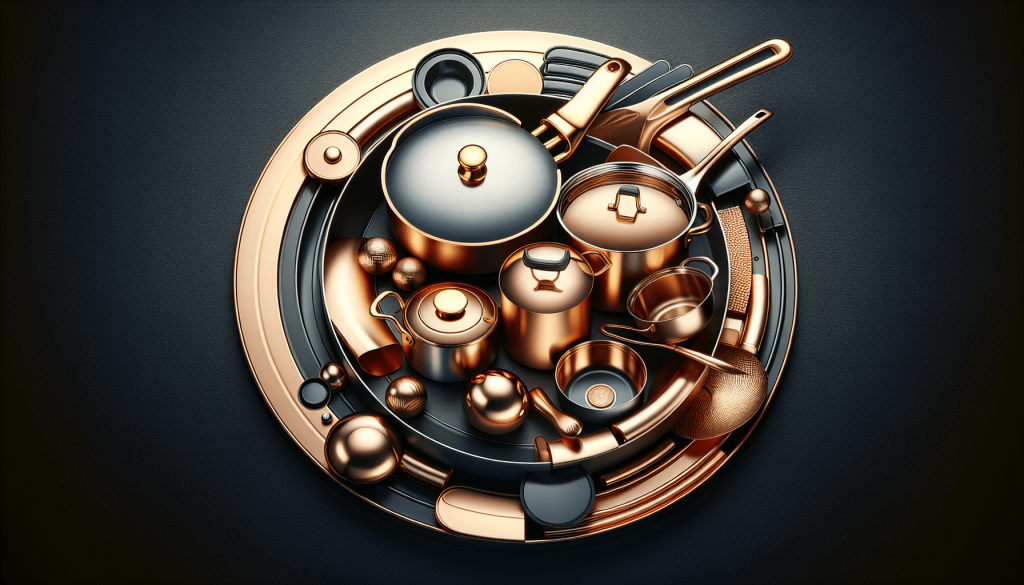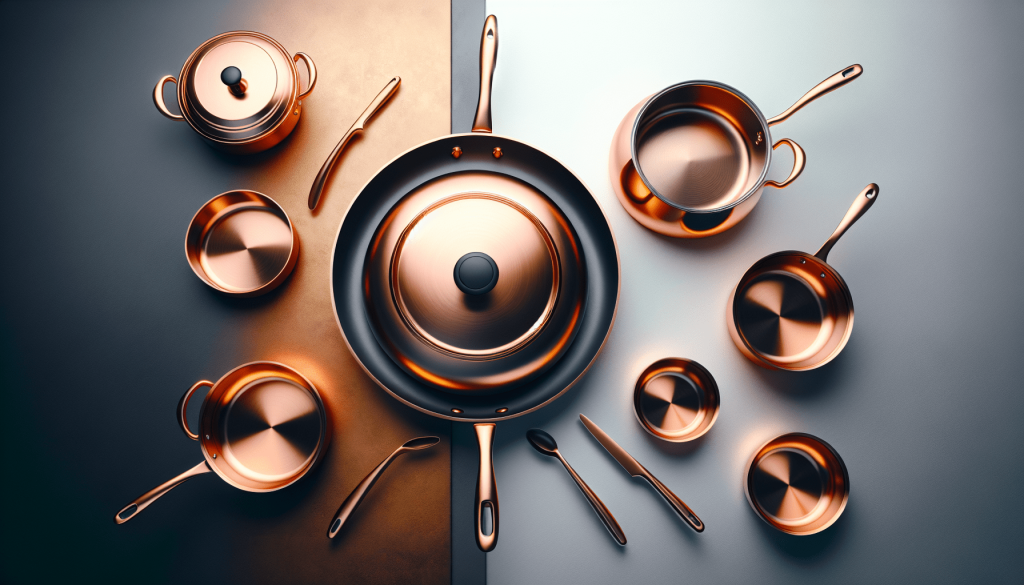If you’re an avid cook or simply enjoy spending time in the kitchen, you’ve probably come across the ongoing debate between copper and aluminum cookware. Both metals have their loyal following, each advocating for their own unique benefits. In this article, we will take a closer look at the battle of the culinary titans – copper versus aluminum – and help you determine which one reigns supreme in the world of cookware. So, grab your apron and let’s get cooking!

Introduction
When it comes to choosing cookware for your kitchen, there are numerous options available. However, two popular choices that often come up in conversations are copper and aluminum cookware. Both these materials offer their unique benefits and features, but determining the better choice depends on various factors. In this article, we will compare copper and aluminum cookware, exploring their heat conductivity, heat distribution, heat responsiveness, durability, reactivity with food, maintenance and care, cost, and aesthetics. By considering these aspects, you can make an informed decision about which cookware material suits your needs best.
Heat Conductivity
Copper possesses excellent heat conductivity, making it a top choice for professional chefs and culinary enthusiasts. It conducts and distributes heat evenly, ensuring your food cooks uniformly and preventing hot spots. With copper cookware, you can expect efficient and precise cooking results, allowing you to prepare delicate dishes with precision and control.
On the other hand, aluminum also offers high heat conductivity. Although not as superior as copper, aluminum’s ability to conduct heat quickly and evenly makes it a popular choice for many home cooks. It heats up faster, reducing cooking time, and provides consistent heat distribution across the cooking surface.
Heat Distribution
In terms of heat distribution, copper excels. Due to its superior heat conductivity, copper cookware delivers even heat distribution, ensuring that every inch of the cooking surface receives the same level of heat. This uniform heat distribution minimizes the chances of food sticking or burning in specific areas, allowing you to achieve optimal cooking results every time.
Similarly, aluminum also provides efficient heat distribution. Its ability to spread heat evenly across the cookware surface ensures that your food cooks consistently, reducing the risk of overcooking or undercooking.

Heat Responsiveness
If you prefer cookware that responds quickly to changes in temperature, copper is your best bet. Copper pans heat up rapidly and cool down just as fast, giving you precise control over your cooking. This responsiveness is particularly useful when you need to adjust heat levels quickly or carry out delicate cooking techniques that require immediate temperature changes.
Aluminum cookware also boasts quick heat-up and cool-down times. Its responsive nature allows you to adapt to changing cooking requirements swiftly. Whether you’re searing a steak or simmering a delicate sauce, aluminum cookware offers the flexibility you need to achieve your desired results.
Durability
When it comes to durability, copper cookware is renowned for its long-lasting nature. With proper care and maintenance, copper pots and pans can serve you for a lifetime. The material is resistant to corrosion and scratches, ensuring its longevity in your kitchen. It can withstand high temperatures and is less likely to warp or dent, making it a robust and reliable option for all your cooking needs.
On the other hand, aluminum is lighter in weight but less durable compared to copper. While aluminum cookware can last for many years with proper care, it is more prone to denting and scratching. However, advancements in manufacturing techniques have led to the development of stronger and more durable aluminum cookware options.
Reactivity with Food
Copper cookware exhibits reactivity with certain types of food, particularly those that are acidic or alkaline in nature. Acidic ingredients, like tomatoes and vinegar, can cause a chemical reaction with copper, resulting in a noticeable metallic taste in the food being prepared. Similarly, alkaline substances, such as baking soda, can cause the copper to corrode and impart a metallic flavor to your dishes. To prevent these reactions, copper cookware is often lined with a layer of tin or stainless steel, creating a safe cooking surface.
Aluminum, on the other hand, has the potential for food reactions, especially when exposed to acidic foods. Acidic ingredients can cause the metal to leach into the food, altering its taste and appearance. To mitigate this, many aluminum cookware manufacturers now offer non-reactive coatings or anodized finishes, ensuring a safer cooking experience.
Maintenance and Care
Copper cookware requires regular maintenance, mainly in the form of polishing. Over time, copper develops a natural patina, which some people find desirable. However, if you prefer the shiny appearance of copper, occasional polishing is necessary to keep it looking pristine. Additionally, copper cookware should be carefully hand-washed using mild detergent and dried immediately to avoid any tarnishing or damage.
On the other hand, aluminum cookware is relatively easy to clean. It is dishwasher safe and requires minimal effort to maintain its appearance. However, to prevent scratches or damage to any non-stick coatings, it is recommended to hand-wash aluminum cookware.
Cost
When it comes to cost, copper cookware tends to be on the higher end of the price spectrum. The high cost can be attributed to copper’s superior heat conductivity and durability. However, investing in copper cookware is often seen as a long-term investment due to its longevity and performance.
In contrast, aluminum cookware is known for its affordability. It offers excellent heat distribution and responsiveness at a more budget-friendly price point. For individuals on a tighter budget or those who are just starting to build their cookware collection, aluminum presents a cost-effective option.
Aesthetics
Copper cookware exudes a classic, luxurious appearance that can elevate the aesthetic appeal of any kitchen. Its warm, coppery tones and gleaming finish add an element of elegance and sophistication. Copper pots and pans are often displayed proudly, doubling as stylish decorative pieces when not in use.
On the other hand, aluminum cookware boasts a modern and sleek look. Its silver or black finishes offer a contemporary touch to any kitchen decor. Aluminum cookware’s minimalist design appeals to individuals who prefer a more streamlined and functional approach to their culinary tools.
Conclusion
In conclusion, choosing between copper and aluminum cookware ultimately depends on your individual needs and preferences. If you prioritize excellent heat conductivity, even heat distribution, rapid heat responsiveness, long-lasting durability, and a luxurious appearance, copper cookware may be the ideal choice for you. However, if affordability, quick heat-up and cool-down times, easy maintenance, and a modern aesthetic are more important, aluminum cookware is worth considering. Assess your cooking style, budget, and desired aesthetic to make an informed decision that will enhance your culinary experiences in the kitchen. Whether you opt for the timeless beauty of copper or the practicality of aluminum, both materials can contribute to creating delicious meals with finesse.
